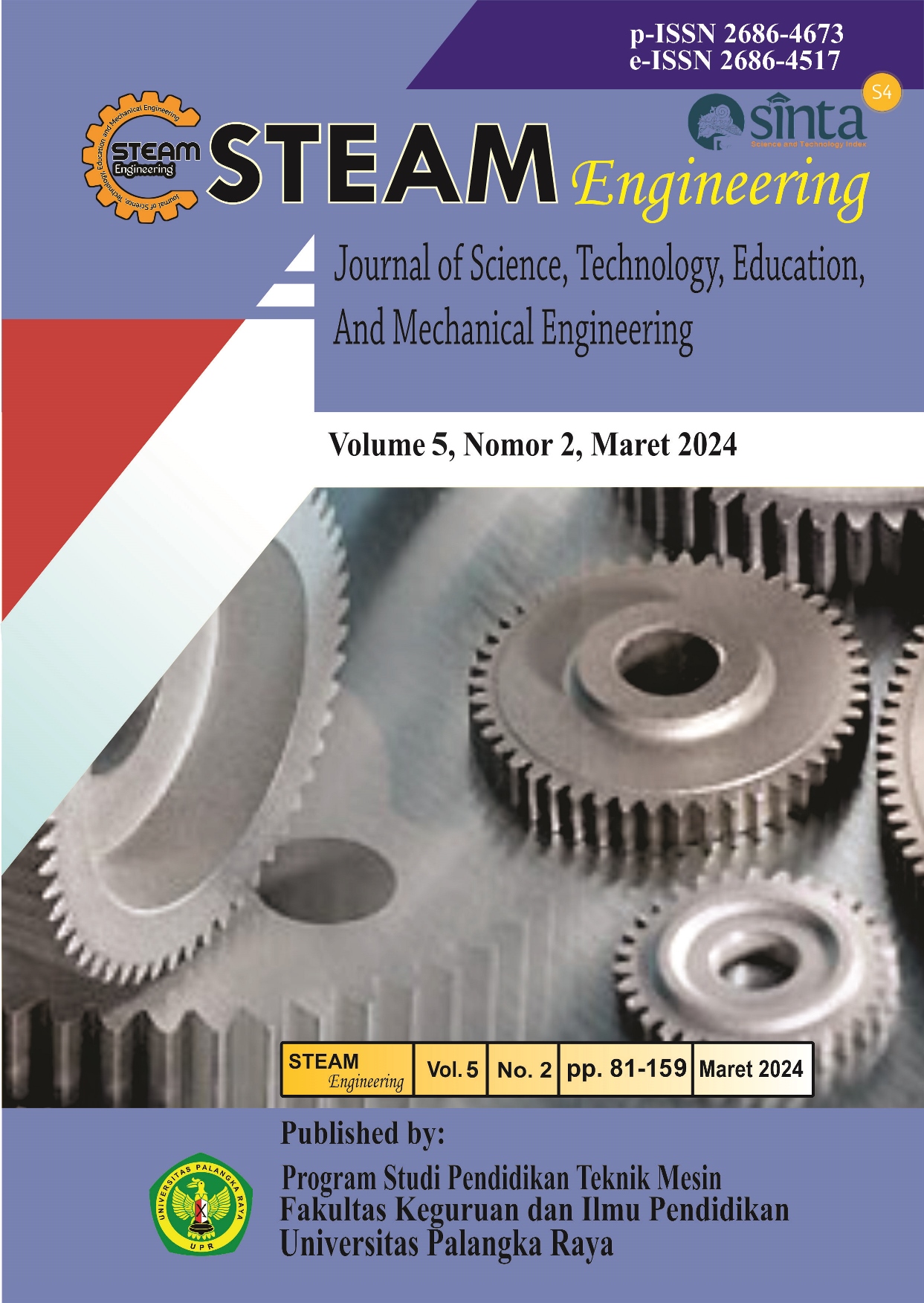ANALISIS KOMPETENSI LULUSAN SMK YANG DIBUTUHKAN DU/DI DENGAN METODE MULTIPLE CRITERIA UTILITY ASSESMENT (MCUA)
DOI:
https://doi.org/10.37304/jptm.v5i2.10058Keywords:
Keywords: Multiple Criteria Utility Assessment, business world, industry world, graduate skillsAbstract
Abstract: The purpose of this study is to determine the competency of SMK graduates with Dudi competence (Business World/Industry World). There is still a gap between the skills possessed by vocational high school graduates and the needs of the business and industry world. This is due to the mismatch between the competencies taught in education and the existing technological developments. Multiple Criteria Utility Assessment (MCUA) is a method used in decision-making that involves multiple criteria or factors that need to be evaluated. This method helps in selecting the best alternative based on objective assessments of various relevant factors. It involves collecting data on criteria relevant to decision-making and then assigning weights or importance to each criterion. Then, each alternative is evaluated based on these criteria, and a value or score is given for each alternative on each criterion. These scores are then used to calculate the utility value for each alternative. The results obtained show that Problem A, which is communication skills with a total value of 165 after being multiplied by the weight, becomes the first priority for improvement. Problem B, management skills, has a total value of 155, making it the third priority for improvement. The total value of 155 becomes the second priority for improvement. Overall, it is necessary to design an integrated and sustainable program in schools or educational institutions to enhance students' communication, planning and organizational skills, as well as their management abilities. Collaboration with industries and the implementation of active and project-based teaching methods can provide practical experiences to students. It is also important to involve experts and industry practitioners in designing programs that are relevant to the current job market needs.
Downloads
References
Abdurrahman, Parmin, & Muryanto, S. (2022). Evaluation on the automotive skill competency test through ‘discontinuity’ model and the competency test management of vocational education school in Central Java, Indonesia. Heliyon, 8(2), e08872. https://doi.org/10.1016/j.heliyon.2022.e08872
Al, M., Marzuki, B., Azlan, S., Polytechnic, S., & Musa, K. (2022). Evaluating the TVET Financial Allocation Based on The Polytechnics and Community Colleges Students ’ Enrolment : A Preliminary Analysis. Human Resource Management Academic Research Society, Vol. 11(2)(June), 1267–1284. https://doi.org/10.6007/IJARPED/v11-i2/13911
Albina, A. C., & Sumagaysay, L. P. (2020). Employability tracer study of Information Technology Education graduates from a state university in the Philippines. Social Sciences & Humanities Open, 2(1), 100055. https://doi.org/10.1016/j.ssaho.2020.100055
Alimudin, I. A., Permana, T., & Sriyono. (2018). Studi kesiapan kerja peserta didik smk untuk bekerja di industri perbaikan bodi otomotif. Journal of Mechanical Engineering Education, 5(2), 179–185.
Ariyanti, Y., & Bowo, P. A. (2018). Pengaruh Prakerin, Status Sosial Ekonomi Keluarga, dan Efikasi Diri Terhadap Kesiapan Kerja . Economic Education Analysis Journal, 7(2), 671–687. http://journal.unnes.ac.id/sju/index.php/eeaj
Bridgstock, R. (2009). The graduate attributes we’ve overlooked: Enhancing graduate employability through career management skills. Higher Education Research and Development, 28(1), 31–44. https://doi.org/10.1080/07294360802444347
Creswell. J.W. (1999). Mixed-Method Research: Introduction and Application. In Handbook of Educational Policy (hal. 455–472). Academic Press. https://doi.org/doi:10.1016/B978-012174698-8/50045-X
Deswarta, D., Mardianty, D., & Bowo, B. (2023). Pengaruh Soft Skill, Hard Skill Dan Motivasi Kerja Terhadap Kesiapan Kerja Mahasiswa Fakultas Ekonomi Dan Bisnis Universitas Islam Riau Dimasa Endemi Covid 19. Management Studies and Entrepreneurship Journal (MSEJ), 4(1), 364–372.
Eliyani, C. (2018). Peran efikasi diri sebagai. Jurnal Mandiri Ilmu Pengetahuan, Seni, dan Teknologi, 2(1), 23–41.
Hamid, A., Shukri, M. I., Rafikul, Manaf, A., & Hazilah, N. (2014). Malaysian graduates ’ employability skills enhancement : an application of the importance performance analysis Rafikul Islam and Abd Manaf Noor Hazilah. J. Global Business Advancement, 7(3), 181–197.
Hidayat, S., & Saleh, M. (2019). Komparasi Kemampuan Kerja Antara Lulusan SMA dan SMK di Industri Permesinan Modern. jurnal IKRA-ITH Ekonomika, 2(1), 45–56.
Ihsan, M. (2018). Analisis Faktor-Faktor Yang Mempengaruhi Kesiapan Kerja Pada Siswa SMK Negeri 1 Sinjai. Jurnal Pendidikan, 6(2), 105–115. https://doi.org/10.36232/pendidikan.v6i2.156
ILO. (2013). Skills for Employment: Enhancing youth employability : The importance of core work skills. Policy Brief, May, 1–8. www.ilo.org/skills
Joye, D. (2005). Qualitative or Quantitative ? Data Archiving in Documentation, Research and Teaching. Forum Qualitative Sozialforschung, 6(2).
K Parangin-Angin, S. (2022). Pengaruh Self Efficacy dan Soft Skill terhadap Kesiapan Kerja Mahasiswa Akhir Angkatan 2018 Pendidikan Ekonomi Universitas Jambi. Universitas Jambi.
Kementerian Pendidikan dan Kebudayaan. (2019). Panduan Pelaksanaan Teaching factory.
Krekel, C., Ward, G., & De Neve, J.-E. (2019). Employee Wellbeing, Productivity, and Firm Performance. SSRN Electronic Journal, March. https://doi.org/10.2139/ssrn.3356581
Lai, E. R. (2011). Critical Thinking: A Literature Review. In Pearson’s Research Reports (Vol. 6, Nomor 1).
Lasi, H., Fettke, P., Kemper, H. G., Feld, T., & Hoffmann, M. (2014). Industry 4.0. Business and Information Systems Engineering, 6(4), 239–242. https://doi.org/10.1007/s12599-014-0334-4
Leavy, P. (2017). Research Design (1 ed.). The Guilford Press A Division of Guilford Publications, Inc. 370 Seventh Avenue, Suite 1200, New York, NY 10001. www.guilford.com
Listyorini, P. I. (2020). Identifikasi Prioritas Masalah Unit Rekam Medis di Puskesmas Nusukan. Jurnal Rekam Medis dan Informasi Kesehatan, 3(1), 24–28. https://doi.org/10.31983/jrmik.v3i1.5574
Mustopa, Hapidin, A., Rayana, J., Bumaeri, A. D. A., & Ahyani, H. (2021). EKSISTENSI MODEL PERGURUAN TINGGI DI LINGKUNGAN PONDOK Abstrak : Model pendidikan tinggi di lingkungan pondok pesantren memang menjadi sesuatu yang baru dalam dinamika pendidikan Islam . Eksistensinya pun semakin dinamis di tengah era 4 . 0 , tentu ada pe. Hikmah, 18(1), 81–90.
Nugraha, H. D., Kencanasari, R. A. V., Komari, R. N., & Kasda, K. (2020). Employability Skills in Technical Vocational Education and Training (TVET). Innovation of Vocational Technology Education, 16(1), 1–10. https://doi.org/10.17509/invotec.v16i1.23509
O’Cathain, A. (2019). Mixed methods research. Qualitative Research in Health Care, 169–180. https://doi.org/10.1002/9781119410867.ch12
Ochieng, F. (2016). MONITORING AND EVALUATION SYSTEMS , TVET / MOE POLICY GUIDELINES AND UTILISATION OF PHYSICAL INFRASTRUCTURAL FACILITIES BY LEARNERS WITH DISABILITIES IN NATIONAL POLYTECHNICS IN KENYA BY. http://erepository.uonbi.ac.ke/handle/11295/97920
OECD, The World Bank, & ILO. (2016). Enhancing employability: Report. 1–34. http://www.oecd.org/g20/topics/employment-and-social-policy/
Osmani, M., Weerakkody, V., Hindi, N., & Eldabi, T. (2019). Graduates employability skills: A review of literature against market demand. Journal of Education for Business, 94(7), 423–432. https://doi.org/10.1080/08832323.2018.1545629
Suharno, Pambudi, N. A., & Harjanto, B. (2020). Vocational education in Indonesia: History, development, opportunities, and challenges. In Children and Youth Services Review (Vol. 115). https://doi.org/10.1016/j.childyouth.2020.105092
Tadle, R. L., Valdez, L. P., Fernandez, R., Uy, C., & Castro, D. (2021). Students ’ Experience of Service Quality of Technical Vocational Education and Training ( TVET ) Programs in Philiphines ’ s Private Higher Educational Institutions ( HEIs ). Journal of Technical Education and Training, 13(3), 29–39.
United Nations Educational, S. and C. O. (UNESCO). (2016). Recommendation concerning Technical and Vocational Education and Training ( TVET ).
Wamsler, C., Schäpke, N., Fraude, C., Stasiak, D., Bruhn, T., Lawrence, M., Schroeder, H., & Mundaca, L. (2020). Enabling new mindsets and transformative skills for negotiating and activating climate action: Lessons from UNFCCC conferences of the parties. Environmental Science and Policy, 112(July), 227–235. https://doi.org/10.1016/j.envsci.2020.06.005
Wibowo, R. A., Myau-Lyau, N., Christy, N. N. A., & Albert. (2022). The Challenges for Indonesia to Integrate Dual Vocational Education and Training System. Journal of Technical Education and Training, 14(2 Special Issue), 79–90. https://doi.org/10.30880/jtet.2022.14.02.008












